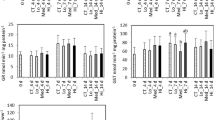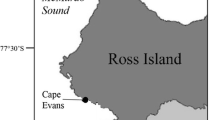Abstract
Residual biological effects of the 1991 HAVEN oil spill off the Ligurian (Arenzano) coast were assessed in this study. Samples of the fish species Boops boops, Mullus barbatus, and Uranoscupus scaber were collected from two polluted sites near the HAVEN wreck and from an uncontaminated area. In addition to this, mussels were caged along the coast affected by the HAVEN disaster. The physiological status of fish and mussels was assessed using a battery of stress and exposure biomarkers. The PAH content of mussel and fish tissues was also analyzed. Significant biological responses were observed in lysosomal membrane stability, neutral lipid and lipofuscin accumulation and micronucleus frequency for mussels caged at two sites close to the HAVEN wreck. Chemical analyses indicated, however, that these effects are not caused by aromatic hydrocarbons. For this reason, we suggest that the aftermath of the HAVEN disaster contributes very little to coastal ecosystem pollution. This was also confirmed by the few biological effects observed in fish specimens (Boops boops) collected from surface waters. Nevertheless, it is important to point out that benthic fish displayed a stress syndrome potentially caused by aromatic hydrocarbons released from the oil tanker, as witnessed by an enhanced EROD activity and increased lipofuscin and neutral lipid lysosomal contents.








Similar content being viewed by others
References
Ausili A, Cicero AM, Ciuffa G, Morlino R, Vacchi M (1994) Tissue level of polyaromatic hydrocarbons in Mediterranean hake. Indagine preliminare sui livelli tissutali di idrocarburi policiclici aromatici in Merluccius merluccius (L) provenienti dai fondi strascicabili del compartimento di Savona. Biol Mar Mediterranea 1(1):43–46
Bolognesi C, Rabboni R, Roggeri P (1996) Genotoxicity biomarkers in M. galloprovincialis as indicators of marine pollutions. Comp Biochem Physiol 113C(2):319–323
Bradford MM (1976) A rapid and sensitive method for the quantitation of microgram quantities of protein utilizing the principle of protein-dye binding. Anal Biochem 72:248–254
Burgeot T, Woll S, Galgani F (1996a) Evalution of the micronucleus test on Mytilus galloprovincialis for monitoring applications along French coasts. Mar Pollut Bull 32(1):39–46
Burgeot T, Bocquene G, Porte C, Dimeet J, Santella RM, Garcia de la Parra LM, Pfhol-Leszkowicz A, Raoux C, Galgani F (1996b) Bioindicators of pollutant exposure in the northwestern Mediterranean Sea. Mar Ecol Prog Ser 131:125–141
Burke MD, Mayer RT (1983) Differential effects of phenobarbitone and 3-methylcholanthrene induction on the hepatic microsomal metabolism and cytochrome P-450-binding of phenoxazone and a homologous series of its n-alkyl ethers (alkoxyresorufins). Chem Biol Interact 45:243–258
Cajaraville MP, Bebianno MJ, Blasco J, Porte C, Sarasquete C, Viarengo A (2000) The use of biomarkers to assess the impact of pollution in coastal environments of the Iberian Peninsula: a practical approach. Sci Total Environ 247:295–311
Danovaro R, Fabiano M, Vinex M (1995) Meiofauna response to the Agip Abruzzo oil spill in subtidal sediments of the Ligurian Sea. Mar Pollut Bull 30(2):133–145
Dauvin JC (1998) The fine sand Abra alba community of the Bay of Morlaix twenty years after the Amoco Cadiz oil spill. Mar Pollut Bull 36:669–676
ENEA (1992) Il monitoraggio ambientale: il caso Haven. Estratto dal Notiziario dell’ENEA. Energia Innovazione 1:24
Escartin E, Porte C (1999) Assessment of PAH pollution in coastal areas from the NW Mediterranean through the analysis of fish bile. Mar Pollut Bull 38(12):1200–1206
Garrigues P, Narbonne JF, Lafaurie M, Ribera D, Lemaire P, Raoux C, Michel X, Salaun JP, Monod JL, Romeo M (1993) Banking of environmental samples for the short-term biochemical and chemical monitoring of organic contamination in coastal marine environments: the GICBEM experience, 1986–1990. Groupe Interface Chimie Biologie des Ecosystèmes, Marins. Sci Total Environ 139/140:225–236
Gorksoyr A, Andersson T, Hansson T, Klungsoyr J, Zhang Y, Forlin L (1987) Species characteristics of the hepatic xenobiotic and steroid biotransformation systems of two teleost fish, Atalntic cod (Gadus morhua) and rainbow trout (Salmo gairdneri). Toxicol Appl Pharmacol 89:347–360
Goldberg ED, Bertine KK (2000) Beyond the Mussel Watch—new directions for monitoring marine pollution. Sci Total Environ 247:165–174
Goldberg EW, Bowen UT, Farrington JW, Robertson W, Schneider E, Harvey G, Martin JH, Parker PL, Risebrough RW, Gamble E (1978) The mussel watch. Environ Conserv 51:1–25
Guidetti P, Modena M, Mesa G, Vacchi M (2000) Composition, abundance and stratification of macrobenthos in the marine area impacted by tar aggregates derived from the Haven oil spill (Ligurian Sea, Italy). Mar Pollut Bull 40(12):1161–1166
Jewett SC, Dean TA, Smith RO, Blanchard A (1999) “Exxon Valdez” oil spill: impacts and recovery in the soft-bottom benthic community and adjacent to eelgrass beds. Mar Ecol Prog Ser 185:59–83
Mersch J, Beauvais MN (1997) The micronucleus assay in the zebra mussel. Dreissena polymorpha, to in situ monitor genotoxicity in freshwater environments. Mutat Res 393:141–149
Moore MN (1976) Cytochemical demonstration of latency of lysosomal hydrolases in digestive gland cells of the common mussel Mytilus edulis, and changes induced by thermal stress. Cell Tissue Res 175:279–287
Myers MS, Johnson LL, Olson OP, Stehr CM, Horness BH, Collier TK, McCain BB (1998) Toxicopathic hepatic lesions as biomarkers of chemical contaminant exposure and effects in marine bottomfish species from the north-east and pacific coasts, USA. Mar Pollut Bull 37(1–2):92–113
Narbonne JF, Garrigues P, Ribera D, Raoux C, Mathieu A, Lemaire P, Salaun JP, Lafaurie M (1991) Mixed-function oxygenase enzymes as tools for pollution monitoring: field studies on the French coast of the Mediterranean Sea. Comp Biochem Physiol 100:37–42
NCR (National Research Council) (1985) Oil in the Sea: inputs, fates and effects. National Academy Press, Washington, DC
Olsson PE, Kling P, Erkell LJ, Kille P (1995) Structural and functional analysis of the rainbow trout (Oncorhyncus mykiss) metallothionein-A gene. Eur J Biochem 230(1):344–349
Payne JF (1976) Field evaluation of benzopyrene hydroxylase induction as a monitor for marine petroleum pollution. Science 191(4230):945–946
Pedrajas JR, Peinado J, Lopez-Barea J. (1995) Oxidative stress in fish exposed to model xenobiotics. Oxidatively modified forms of Cu,Zn-superoxide dismutase as potential biomarkers. Chem Biol Interact 98(3):267–282
Pietrapiana D, Modena M, Guidetti P, Falugi C, Vacchi M (2002) Evaluating the genotoxic damage and hepatic tissue alterations in demersal fish species: a case study in the Ligurian Sea (NW – Mediterranean). Mar Pollut Bull 44:238–243
Regoli F, Pellegrini D, Winston GW, Gorbi S, Giuliani S, Virno-Lamberti C, Bompadre S (2002) Application of biomarkers for assessing the biological impact of dredged materials in the Mediterranean: the relationship between antioxidant responses and susceptibility to oxidative stress in the red mullet (Mullus barbatus). Mar Pollut Bull 44:912–922
Relini G (1994) Marine ecosystem after VLCC Haven disaster. Gli ecosistemi e le risorse biologiche del Mar Ligure dopo il disastro della Haven. Biol Mar Mediterranea 1(1):3–42
Roseijadi G (1992) Metallothionein in metal regulation and toxicity in aquatic animals. Aquat Toxicol 22:81–114
UNEP/RAMOGE (1999) Manual on the biomarkers recommended for the MED POL Biomonitoring Programme. UNEP, Athens
US EPA (1998) Method 8270D: semivolatile organic compounds by gas chromatography/mass spectrometry. US EPA, Washington, DC
Viarengo A (1989) Heavy metals in marine invertebrates: mechanism of regulation and toxicity at the cellular level. CRC Crit Rev Aquat Sci 1:295–317
Viarengo A, Canesi L (1991) Musells as biological indicators of pollution. Aquaculture 94:225–243
Viarengo A, Canesi L, Pertica M, Mancinelli G, Accomando G, Smaal AC, Orunesu M (1995) Stress on stress response: a simple monitoring tool in the assessment of a general stress syndrome in mussels. Mar Environ Res 39:245–248
Viarengo A, Ponzano E, Dondero F, Fabbri R (1997) A simple spectrophotometric method for metallothionein evaluation in marine organisms: an application to Mediterranean and Antarctic molluscs. Mar Environ Res 44:69–84
Viarengo A, Burlando B, Dondero F, Marro A, Fabbri R (1999) Metallothionein as a tool in biomonitoring programmes. Biomarkers 4:455–466
Viarengo A, Burlando B, Ceratto N, Panfili I (2000) Antioxidant role of metallothioneins: a comparative overview. Mol Cell Biol (Noisy-le-grand) 46:407–417
Acknowledgment
This study was supported by Regione Liguria (Dipartimento Ambiente e Territorio, Ufficio Ambiente Marino e Costiero) “Programma per la valutazione mediante bioindicatori dell’inquinamento chimico prodotto dall’affondamento della m/n Haven.”
Author information
Authors and Affiliations
Corresponding author
Rights and permissions
About this article
Cite this article
Viarengo, A., Dondero, F., Pampanin, D.M. et al. A Biomonitoring Study Assessing the Residual Biological Effects of Pollution Caused by the HAVEN Wreck on Marine Organisms in the Ligurian Sea (Italy). Arch Environ Contam Toxicol 53, 607–616 (2007). https://doi.org/10.1007/s00244-005-0209-2
Received:
Accepted:
Published:
Issue Date:
DOI: https://doi.org/10.1007/s00244-005-0209-2




